
Jean Bart was a protected cruiser of the Jean Bart class built for the French Navy in the late 1880s and early 1890s. The lead ship the class of two ships, Jean Bart and her sister ship were ordered during the tenure of Admiral Théophile Aube as Minister of Marine according to the theories of the Jeune École doctrine. The ships were intended as long-range commerce raiders, and they were armed with a main battery of four 164 mm (6.5 in) guns, were protected by an armor deck that was 50 to 100 mm thick, and were capable of steaming at a top speed of 19.5 knots.

Bayard was the lead ship of the Bayard class of ironclad barbette ships built for the French Navy in the late 1870s and 1880s. Intended for service in the French colonial empire, she was designed as a "station ironclad", smaller versions of the first-rate vessels built for the main fleet. The Vauban class was a scaled down variant of Amiral Duperré. They carried their main battery of four 240 mm (9.4 in) guns in open barbettes, two forward side-by-side and the other two aft on the centerline. Bayard was laid down in 1876 and was commissioned in 1882.

Amiral Cécille was a protected cruiser of the French Navy, named in honour of Jean-Baptiste Cécille. The third vessel of that type built in France, her design was derived from her two predecessors, Sfax and Tage. Like those vessels, Amiral Cécille was intended to be used as a commerce raider to attack merchant shipping. As such, she carried a barque sailing rig to supplement her steam engines for long voyages overseas. Amiral Cécille was armed with a main battery of eight 164 mm (6.5 in) guns and had a curved armor deck that was 56 to 102 mm thick.

Troude was a protected cruiser of the French Navy, the lead ship of the Troude class. The class was built as part of a construction program intended to provide scouts for the main battle fleet. They were based on the preceding Forbin class, the primary improvement being the addition of armor to the conning tower. Troude was built in the 1880s and was completed in late 1890. She was armed with a main battery of four 138 mm (5.4 in) guns, protected with an armor deck that was 41 mm (1.6 in) thick, and had a top speed of 20.5 knots.

Milan was a late-19th-century unprotected cruiser in the French Navy. At the time of her completion, Milan was considered by several publications to be the fastest warship in the world. The warship was the last unprotected cruiser in French naval service, and Milan's design influenced the construction of later protected cruisers.

The Troude class was a group of three protected cruisers built for the French Navy in the late 1880s and early 1890s. The class, which was very similar to the preceding Forbin class, comprised Troude, Cosmao and Lalande. They were ordered as part of a fleet program that accorded with the theories of the Jeune École, which proposed a fleet based on cruisers and torpedo boats to defend France. The Troude-class cruisers were intended to serve as flotilla leaders for the torpedo boats, and they were armed with a main battery of four 138 mm (5.4 in) guns.

Vauban was the lead ship of the Vauban class of ironclad barbette ships built for the French Navy in the late 1870s and 1880s. Intended for service in the French colonial empire, she was designed as a "station ironclad", smaller versions of the first-rate vessels built for the main fleet. The Vauban class was a scaled down variant of Amiral Duperré. They carried their main battery of four 240 mm (9.4 in) guns in open barbettes, two forward side-by-side and the other two aft on the nautical. Vauban was laid down in 1879 and was completed in 1885.

Tage was a protected cruiser built for the French Navy in the 1880s, the second vessel of that type built for the French fleet. The design was based on the previous cruiser, Sfax, and like that vessel, Tage was intended to be used as a commerce raider to attack merchant shipping. As such, she carried a barque sailing rig to supplement her steam engines for long voyages overseas. Tage was armed with a main battery of eight 164 mm (6.5 in) guns and had a curved armor deck that was 51 to 56 mm thick.
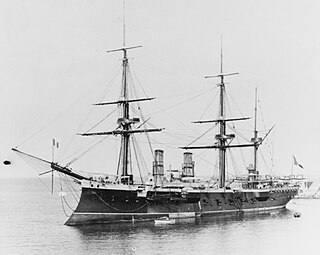
Sfax was a protected cruiser built for the French Navy in the 1880s. She was the first vessel of the type to be built for the French Navy, which was a development from earlier unprotected cruisers like Milan. Unlike the earlier vessels, Sfax carried an armor deck that covered her propulsion machinery and ammunition magazines. Intended to be used as a commerce raider in the event of war with Great Britain, Sfax was rigged as a barque to supplement her engines on long voyages abroad. She was armed with a main battery of six 164 mm (6.5 in) guns and a variety of lighter weapons.

Forbin was a protected cruiser, the lead ship of the Forbin class, built in the late 1880s for the French Navy. The class was built as part of a construction program intended to provide scouts for the main battle fleet. They were based on the earlier unprotected cruiser Milan, with the addition of an armor deck to improve their usefulness in battle. They had a high top speed for the time, at around 20 knots, and they carried a main battery of four 138 mm (5.4 in) guns.
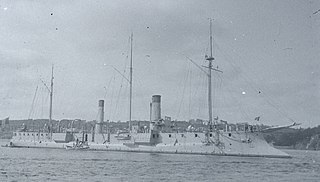
Surcouf was the second Forbin-class protected cruiser built for the French Navy in the late 1880s and early 1890s. The Forbin-class cruisers were built as part of a construction program intended to provide scouts for the main battle fleet. They were based on the earlier unprotected cruiser Milan, with the addition of an armor deck to improve their usefulness in battle. They had a high top speed for the time, at around 20 knots, and they carried a main battery of four 138 mm (5.4 in) guns.

Isly was a Jean Bart-class protected cruiser built in the late 1880s and early 1890s for the French Navy. The second and final member of the class, Isly and her sister ship were ordered during the tenure of Admiral Théophile Aube as Minister of Marine according to the theories of the Jeune École doctrine. The ships were intended as long-range commerce raiders, and they were armed with a main battery of four 164 mm (6.5 in) guns, were protected by an armor deck that was 50 to 100 mm thick, and were capable of steaming at a top speed of around 19 knots.
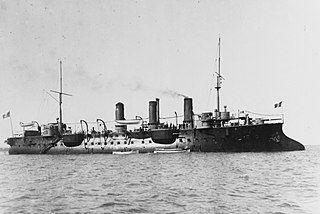
Bugeaud was a Friant-class protected cruiser of the French Navy built in the 1890s, the second of three ships of the class. The Friant-class cruisers were ordered as part of a construction program directed at strengthening the fleet's cruiser force. At the time, France was concerned with the growing naval threat of the Italian and German fleets, and the new cruisers were intended to serve with the main fleet, and overseas in the French colonial empire. Bugeaud and her two sister ships were armed with a main battery of six 164 mm (6.5 in) guns, were protected by an armor deck that was 30 to 80 mm thick, and were capable of steaming at a top speed of 18.7 knots.

Descartes was the lead ship of the Descartes class of protected cruisers built for the French Navy in the 1890s. The Descartes-class cruisers were ordered as part of a construction program directed at strengthening the fleet's cruiser force. At the time, France was concerned with the growing naval threat of the Italian and German fleets, and the new cruisers were intended to serve with the main fleet, and overseas in the French colonial empire. Descartes was armed with a main battery of four 164.7 mm (6.5 in) guns, was protected by an armor deck that was 20 to 40 mm thick, and was capable of steaming at a top speed of 19 knots.

Catinat was the lead ship of the Catinat class of protected cruisers built for the French Navy in the 1890s. The Catinat-class cruisers were ordered as part of a construction program directed at strengthening the fleet's cruiser force at a time the country was concerned with the growing naval threat of the Italian and German fleets. The new cruisers were intended to serve with the main fleet and overseas in the French colonial empire. Catinat was armed with a main battery of four 164 mm (6.5 in) guns, was protected by an armor deck that was 25 to 60 mm thick, and was capable of steaming at a top speed of up to 20 knots.

Protet was a protected cruiser of the French Navy built in the 1890s, the second and final member of the Catinat class. The Catinat-class cruisers were ordered as part of a construction program directed at strengthening the fleet's cruiser force at a time when the country was concerned with the growing naval threat of the Italian and German fleets. The new cruisers were intended to serve with the main fleet and overseas in the French colonial empire. Protet was armed with a main battery of four 164 mm (6.5 in) guns, was protected by an armor deck that was 25 to 60 mm thick, and was capable of steaming at a top speed of up to 20 knots.
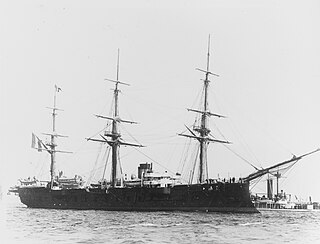
Aréthuse was an unprotected cruiser built for the French Navy. The ship was laid down in 1879 and completed in 1885. Intended to serve as a long-range commerce raider, the ship was fitted with a sailing rig to supplement its steam engine on long voyages, and she carried an armament of four 165 mm (6.5 in) and twenty-two 140 mm (5.5 in) guns. She was among the final French unprotected cruisers, thereafter being replaced by more durable protected cruisers.

Cassini was the second member of the D'Iberville class of torpedo cruisers built for the French Navy in the 1890s. The class is also sometimes classified as torpedo gunboats or torpedo avisos. The D'Iberville-class ships were a development of earlier torpedo cruisers, with the chief improvement being a significantly higher speed. Cassini was armed with three 450 mm (17.7 in) torpedo tubes and a single 100 mm (3.9 in) gun as her primary offensive armament.
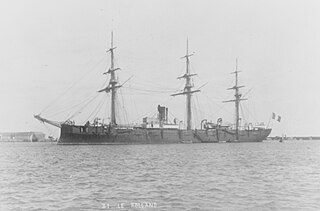
Roland was an unprotected cruiser of the Villars class built for the French Navy in the 1870s, the fourth and final member of the class. The ships were designed for service in the French colonial empire, and they carried a relatively heavy battery of fifteen 138.6 mm (5.46 in) guns, and could steam at a speed of 14.5 knots. The ship was laid down in 1877 and she was completed in 1884. She was deployed to East Asia during the Sino-French War in January 1885, but the conflict had ended by the time she arrived. After completing her tour in East Asian waters, she served a stint in the North Atlantic Squadron from 1890, a role she filled for much of the decade, between periods out of service in reserve. Roland was ultimately struck from the naval register in 1897 and sold for scrap the following year.





















